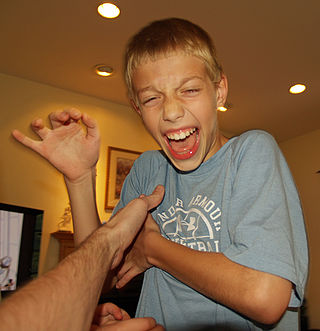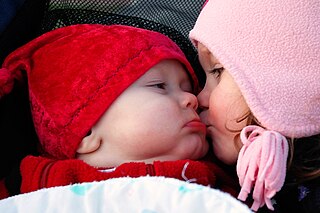
A kiss is the touch or pressing of one's lips against another person or an object. Cultural connotations of kissing vary widely. Depending on the culture and context, a kiss can express sentiments of love, passion, romance, sexual attraction, sexual activity, sexual arousal, affection, respect, greeting, peace, and good luck, among many others. In some situations, a kiss is a ritual, formal or symbolic gesture indicating devotion, respect, or a sacramental. The word came from Old English cyssan, in turn from coss.

Physical intimacy is sensuous proximity or touching. It is an act or reaction, such as an expression of feelings, between people. Examples of physical intimacy include being inside someone's personal space, holding hands, hugging, kissing, caressing and sexual activity. Physical intimacy can often convey the real meaning or intention of an interaction in a way that accompanying speech cannot do. Physical intimacy can be exchanged between any people but as it is often used to communicate positive and intimate feelings, it most often occurs in people who have a preexisting relationship, whether familial, platonic or romantic, with romantic relationships having increased physical intimacy. Several forms of romantic touch have been noted including holding hands, hugging, kissing, cuddling, as well as caressing and massaging. Physical affection is highly correlated with overall relationship and partner satisfaction.
Proxemics is the study of human use of space and the effects that population density has on behavior, communication, and social interaction.

Body language is a type of communication in which physical behaviors, as opposed to words, are used to express or convey information. Such behavior includes facial expressions, body posture, gestures, eye movement, touch and the use of space. The term body language is usually applied in regard to people but may also be applied to animals. The study of body language is also known as kinesics. Although body language is an important part of communication, most of it happens without conscious awareness.

Public displays of affection (PDA) are acts of physical intimacy in the view of others. What is considered to be an acceptable display of affection varies with respect to culture and context.

Greeting is an act of communication in which human beings intentionally make their presence known to each other, to show attention to, and to suggest a type of relationship or social status between individuals or groups of people coming in contact with each other. Greetings are sometimes used just prior to a conversation or to greet in passing, such as on a sidewalk or trail. While greeting customs are highly culture- and situation-specific and may change within a culture depending on social status and relationship, they exist in all known human cultures. Greetings can be expressed both audibly and physically, and often involve a combination of the two. This topic excludes military and ceremonial salutes but includes rituals other than gestures. A greeting, or salutation, can also be expressed in written communications, such as letters and emails.

Cheek kissing is a ritual or social kissing gesture to indicate friendship, family relationship, perform a greeting, to confer congratulations, to comfort someone, or to show respect.

Haptic communication is a branch of nonverbal communication that refers to the ways in which people and animals communicate and interact via the sense of touch. Touch is the most sophisticated and intimate of the five senses. Touch or haptics, from the ancient Greek word haptikos is extremely important for communication; it is vital for survival.

An Eskimo kiss, nose kiss, or nose rub is a gesture of affection where one rubs the tip of one's nose against another person's face. In Inuit culture, the gesture is known as a kunik, and consists of pressing or rubbing the tip of one's nose against another's cheek. In non-Inuit English-speaking culture, two people Eskimo kiss by rubbing the tips of their noses together. Nose-to-cheek kisses are found in other cultures as well.
Kinesics is the interpretation of body communication such as facial expressions and gestures, nonverbal behavior related to movement of any part of the body or the body as a whole. The equivalent popular culture term is body language, a term Ray Birdwhistell, considered the founder of this area of study, neither used nor liked.

Oculesics, a subcategory of kinesics, is the study of eye movement, behavior, gaze, and eye-related nonverbal communication. The term's specific designation slightly varies apropos of the field of study. Communication scholars use the term "oculesics" to refer to the investigation of culturally-fluctuating propensities and appreciations of visual attention, gaze and other implicitly effusive elements of the eyes. Comparatively, medical professionals may ascribe the same appellation to the measurement of a patient's ocular faculty, especially subsequent a cerebral or other injury.
Pillow talk is the relaxed, intimate conversation that can occur between sexual partners after sexual activity, usually accompanied by cuddling, caresses, kissing, and other physical intimacy. It is associated with honesty, sexual afterglow, and bonding, and is distinguished from dirty talk which sometimes forms part of foreplay and of sexual act.
A valediction, or complimentary close in American English, is an expression used to say farewell, especially a word or phrase used to end a letter or message, or a speech made at a farewell.
The following outline is provided as an overview of and topical guide to interpersonal relationships.
Etiquette in Latin America varies by country and by region within a given country.

Knapp's relational development model portrays relationship development as a ten step process, broken into two phases. Created by and named after communication scholar Mark L. Knapp, the model suggests that all of the steps should be done one at a time, in sequence, to make sure they are effective. However, not every relationship will go through these stages of development in the same way. Compared to DeVito's six-stage model of relational development, Knapp's model is far more prescriptive and detailed, but also presupposes that the relationship will ultimately dissolve, as evident in the five "coming apart" stages that make up the second half of the model. However, Knapp himself has said that his model is also descriptive; the model describes what seems to happen, not necessarily what should happen. The model proposes that coming apart need not be seen as inherently bad, just as coming together need not be seen as inherently good.

Many societies have traditions which involve kissing. Kissing can indicate joy or be used as part of a greeting. Kissing involves the touching of one's lips to the lips or other body part, such as the cheek, head or hand of another person. Sometimes people often kiss their friends as a way of giving luck or even showing feelings.
Body-to-body communication is a way of communicating with others through the use of nonverbal communication, without using speech or verbalization. It can include body language, facial expressions, and other bodily gestures in order to communicate with others without the need of verbal communication. Body-to-body communication accounts for postures, body language, physical touch, nonverbal language, and other bodily gestures.
Social cues are verbal or non-verbal signals expressed through the face, body, voice, motion and guide conversations as well as other social interactions by influencing our impressions of and responses to others. These percepts are important communicative tools as they convey important social and contextual information and therefore facilitate social understanding.

The socialist fraternal kiss was a special form of greeting between socialist state leaders. The act demonstrated the special connection that exists between Communist countries, consisting of an embrace, along with a series of three kisses on alternate cheeks. In rare cases, when the two leaders considered themselves exceptionally close, the kisses were given on the mouth rather than on the cheeks.

















